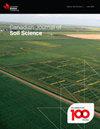Improved parent material map disaggregation methods in the Saskatchewan prairies using historical bare soil composite imagery
IF 1.5
4区 农林科学
Q4 SOIL SCIENCE
引用次数: 1
Abstract
Abstract The major drivers of soil variation in Saskatchewan at scales finer than the existing soil maps are parent material variance, slope position, and salinity. There is therefore a need to generate finer-scale parent material maps as part of updating soil maps in Saskatchewan. As spatially referenced soil point data are lacking in Saskatchewan, predictive soil mapping methods that disaggregate existing soil parent material maps are required. This study focused on investigating important environmental covariates to use in parent material disaggregation, particularly bare soil composite imagery (BSCI). Synthetic point observations were generated using an area-proportional approach based on existing soil survey polygons and a random forest model was trained with those synthetic observations to predict parent material classes. Including BSCI as environmental covariates increased model accuracy from 0.38 to 0.52 and the model Kappa score from 0.19 to 0.35 compared with models where it was not included. Models that included training points from all locations, regardless of whether BSCI was available, and included BSCI as environmental covariates had similar results to the BSCI model with an accuracy of 0.48 and a Kappa value of 0.30. Based on these results, BSCI is an important covariate for parent material disaggregation in the Saskatchewan Prairies. Future work to disaggregate soil classes based on slope position and salinity, and to combine those methods with parent material disaggregation is needed to generate detailed soil maps for the Canadian Prairies.萨斯喀彻温大草原裸地复合影像母质图分解方法的改进
摘要萨斯喀彻温省土壤变化的主要驱动因素是母质变化、坡度和盐度。因此,作为萨斯喀彻温省土壤地图更新的一部分,需要生成更精细的母材地图。由于萨斯喀彻温省缺乏空间参考的土壤点数据,因此需要对现有土壤母质地图进行分解的预测性土壤制图方法。这项研究的重点是调查在母体物质分解中使用的重要环境协变量,特别是裸土复合图像(BSCI)。使用基于现有土壤调查多边形的面积比例方法生成合成点观测值,并使用这些合成观测值训练随机森林模型来预测母材类别。与未包括BSCI的模型相比,将BSCI作为环境协变量将模型精度从0.38提高到0.52,将模型Kappa评分从0.19提高到0.35。包括来自所有位置的训练点的模型,无论BSCI是否可用,并包括BSCI作为环境协变量,其结果与BSCI模型相似,精度为0.48,Kappa值为0.30。基于这些结果,BSCI是萨斯喀彻温大草原母体物质分解的一个重要协变量。未来需要根据斜坡位置和盐度对土壤类别进行分类,并将这些方法与母体材料分类相结合,以生成加拿大大草原的详细土壤地图。
本文章由计算机程序翻译,如有差异,请以英文原文为准。
求助全文
约1分钟内获得全文
求助全文
来源期刊

Canadian Journal of Soil Science
农林科学-土壤科学
CiteScore
2.90
自引率
11.80%
发文量
73
审稿时长
6.0 months
期刊介绍:
The Canadian Journal of Soil Science is an international peer-reviewed journal published in cooperation with the Canadian Society of Soil Science. The journal publishes original research on the use, management, structure and development of soils and draws from the disciplines of soil science, agrometeorology, ecology, agricultural engineering, environmental science, hydrology, forestry, geology, geography and climatology. Research is published in a number of topic sections including: agrometeorology; ecology, biological processes and plant interactions; composition and chemical processes; physical processes and interfaces; genesis, landscape processes and relationships; contamination and environmental stewardship; and management for agricultural, forestry and urban uses.
 求助内容:
求助内容: 应助结果提醒方式:
应助结果提醒方式:


